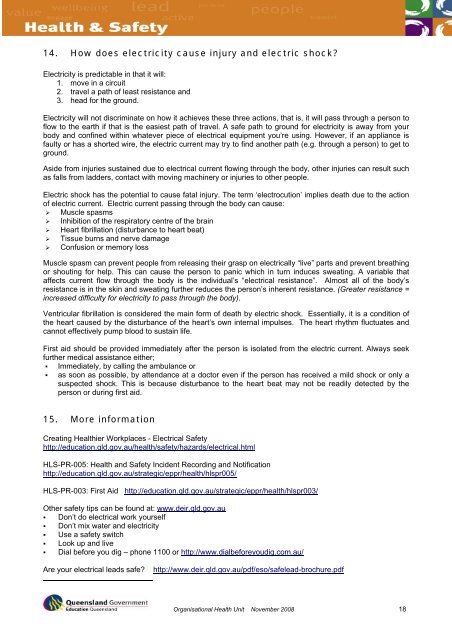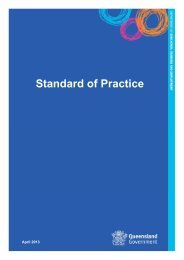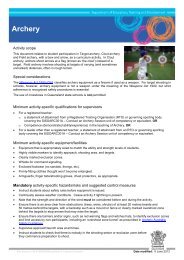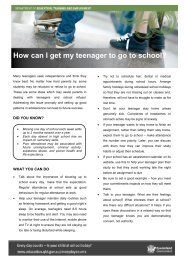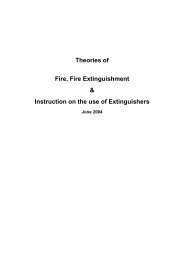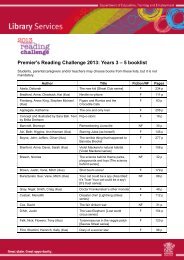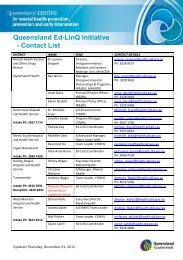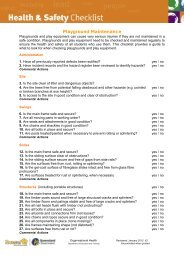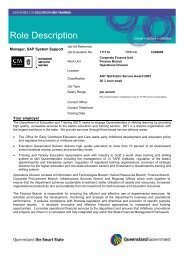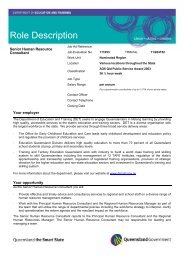1. What must be done to ensure electrical safety in schools? 2 ...
1. What must be done to ensure electrical safety in schools? 2 ...
1. What must be done to ensure electrical safety in schools? 2 ...
Create successful ePaper yourself
Turn your PDF publications into a flip-book with our unique Google optimized e-Paper software.
14. How does electricity cause <strong>in</strong>jury and electric shock?<br />
Electricity is predictable <strong>in</strong> that it will:<br />
<strong>1.</strong> move <strong>in</strong> a circuit<br />
2. travel a path of least resistance and<br />
3. head for the ground.<br />
Electricity will not discrim<strong>in</strong>ate on how it achieves these three actions, that is, it will pass through a person <strong>to</strong><br />
flow <strong>to</strong> the earth if that is the easiest path of travel. A safe path <strong>to</strong> ground for electricity is away from your<br />
body and conf<strong>in</strong>ed with<strong>in</strong> whatever piece of <strong>electrical</strong> equipment you’re us<strong>in</strong>g. However, if an appliance is<br />
faulty or has a shorted wire, the electric current may try <strong>to</strong> f<strong>in</strong>d another path (e.g. through a person) <strong>to</strong> get <strong>to</strong><br />
ground.<br />
Aside from <strong>in</strong>juries susta<strong>in</strong>ed due <strong>to</strong> <strong>electrical</strong> current flow<strong>in</strong>g through the body, other <strong>in</strong>juries can result such<br />
as falls from ladders, contact with mov<strong>in</strong>g mach<strong>in</strong>ery or <strong>in</strong>juries <strong>to</strong> other people.<br />
Electric shock has the potential <strong>to</strong> cause fatal <strong>in</strong>jury. The term ‘electrocution’ implies death due <strong>to</strong> the action<br />
of electric current. Electric current pass<strong>in</strong>g through the body can cause:<br />
Muscle spasms<br />
Inhibition of the respira<strong>to</strong>ry centre of the bra<strong>in</strong><br />
Heart fibrillation (disturbance <strong>to</strong> heart <strong>be</strong>at)<br />
Tissue burns and nerve damage<br />
Confusion or memory loss<br />
Muscle spasm can prevent people from releas<strong>in</strong>g their grasp on <strong>electrical</strong>ly “live” parts and prevent breath<strong>in</strong>g<br />
or shout<strong>in</strong>g for help. This can cause the person <strong>to</strong> panic which <strong>in</strong> turn <strong>in</strong>duces sweat<strong>in</strong>g. A variable that<br />
affects current flow through the body is the <strong>in</strong>dividual’s “<strong>electrical</strong> resistance”. Almost all of the body’s<br />
resistance is <strong>in</strong> the sk<strong>in</strong> and sweat<strong>in</strong>g further reduces the person’s <strong>in</strong>herent resistance. (Greater resistance =<br />
<strong>in</strong>creased difficulty for electricity <strong>to</strong> pass through the body).<br />
Ventricular fibrillation is considered the ma<strong>in</strong> form of death by electric shock. Essentially, it is a condition of<br />
the heart caused by the disturbance of the heart’s own <strong>in</strong>ternal impulses. The heart rhythm fluctuates and<br />
cannot effectively pump blood <strong>to</strong> susta<strong>in</strong> life.<br />
First aid should <strong>be</strong> provided immediately after the person is isolated from the electric current. Always seek<br />
further medical assistance either;<br />
Immediately, by call<strong>in</strong>g the ambulance or<br />
as soon as possible, by attendance at a doc<strong>to</strong>r even if the person has received a mild shock or only a<br />
suspected shock. This is <strong>be</strong>cause disturbance <strong>to</strong> the heart <strong>be</strong>at may not <strong>be</strong> readily detected by the<br />
person or dur<strong>in</strong>g first aid.<br />
15. More <strong>in</strong>formation<br />
Creat<strong>in</strong>g Healthier Workplaces - Electrical Safety<br />
http://education.qld.gov.au/health/<strong>safety</strong>/hazards/<strong>electrical</strong>.html<br />
HLS-PR-005: Health and Safety Incident Record<strong>in</strong>g and Notification<br />
http://education.qld.gov.au/strategic/eppr/health/hlspr005/<br />
HLS-PR-003: First Aid http://education.qld.gov.au/strategic/eppr/health/hlspr003/<br />
Other <strong>safety</strong> tips can <strong>be</strong> found at: www.deir.qld.gov.au<br />
Don’t do <strong>electrical</strong> work yourself<br />
Don’t mix water and electricity<br />
Use a <strong>safety</strong> switch<br />
Look up and live<br />
Dial <strong>be</strong>fore you dig – phone 1100 or http://www.dial<strong>be</strong>foreyoudig.com.au/<br />
Are your <strong>electrical</strong> leads safe? http://www.deir.qld.gov.au/pdf/eso/safelead-brochure.pdf<br />
Organisational Health Unit Novem<strong>be</strong>r 2008 18


